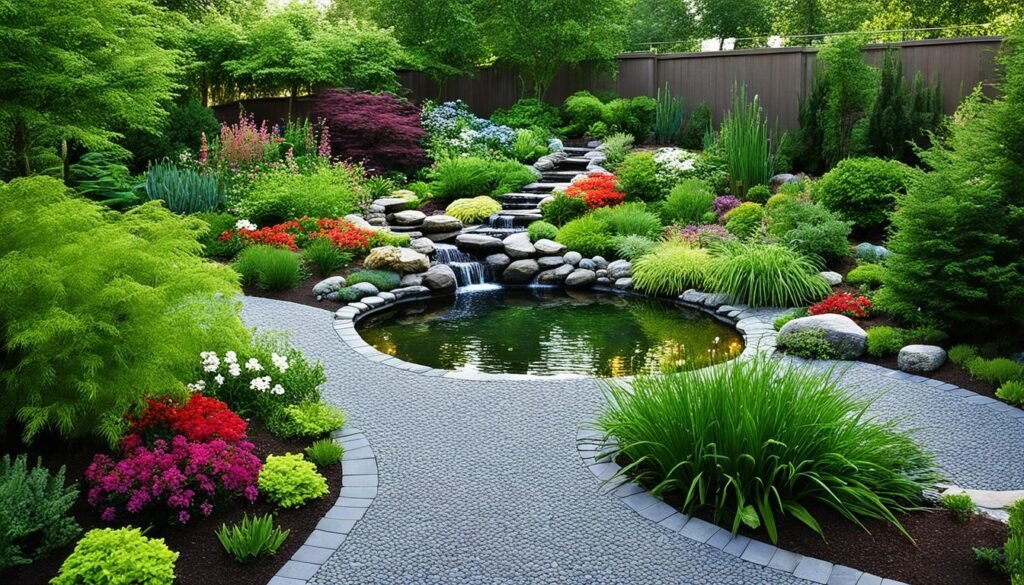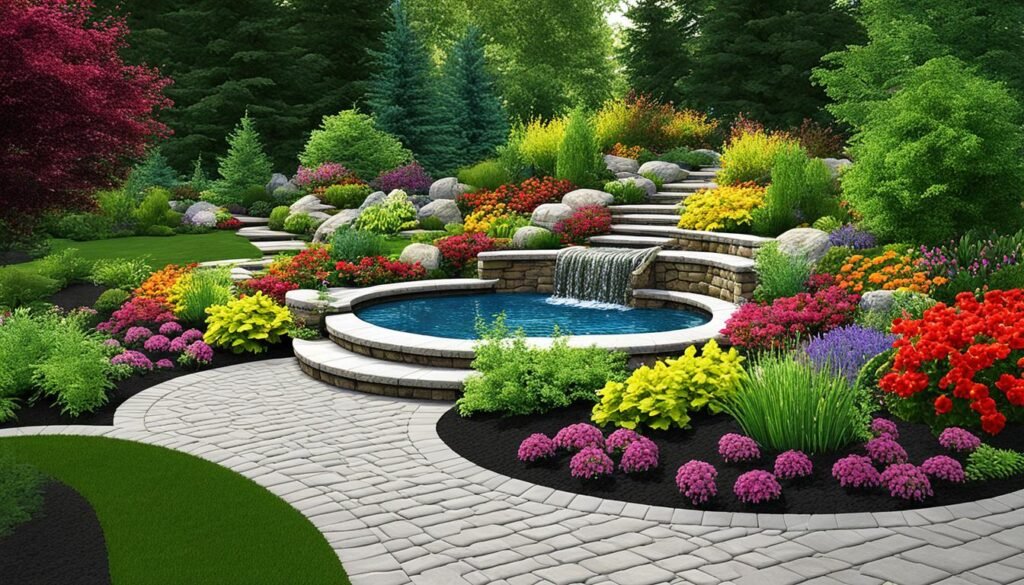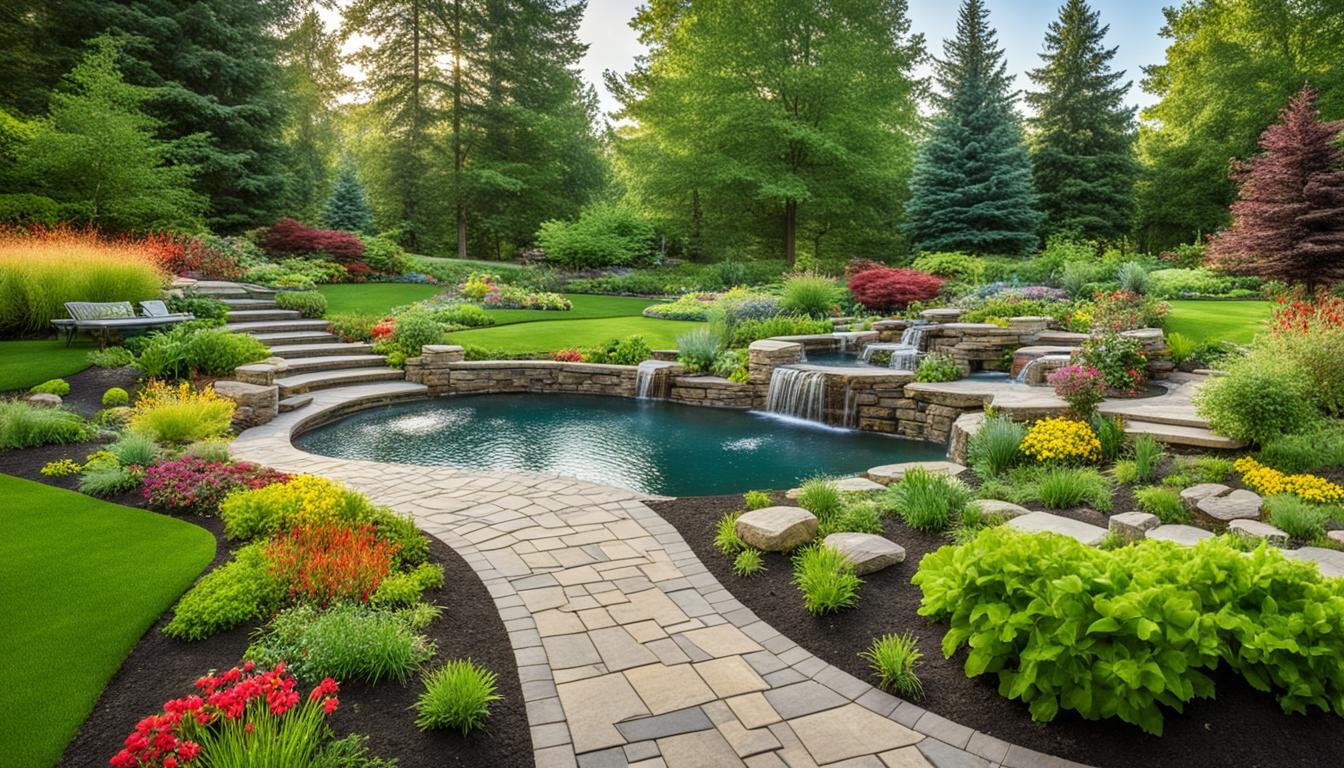Want to make your backyard stunning and reflect your style? Learn how to landscape your space so it’s both pretty and useful. You can improve entrances, soften hard areas, and choose plants with care. These tips will help your backyard impress everyone.
Plan and design with thought, and your backyard can become a peaceful spot or a place for fun. Imagine all the ways you can enhance your outdoor area. Are you excited to upgrade your backyard?
Key Takeaways:
- By enhancing the entries, you can create a welcoming and visually appealing backyard.
- Well-defined edging adds a well-cared-for look to your landscape.
- Softening hardscape elements blends them seamlessly into the surroundings.
- Planting in masses creates stunning flower beds.
- Layering beds by height creates a lush and visually appealing garden.
Enhance the entries
Making your backyard’s entrance more welcoming and pretty is key. With smart landscaping, you can craft a beautiful, welcoming entry. These ideas might help:
Cluster plants for natural integration
Putting plants together near your home’s foundation and steps works well. It makes your home blend with nature, giving a unified look. Pick plants that match your home’s style and colors. This way, you can smoothly link your home’s outside to the backyard.
Add an informal touch with unmatched containers
For a fun entry, use different containers with colorful flowers. It adds fun and lets you show off your creative side. Use all shapes and sizes of containers. Then, fill them with flowers that do well in your weather. This brings colors and textures to your doorway.
Incorporate decorative elements for a friendly atmosphere
Decor like stone pups makes your backyard inviting. These details grab attention and make the space more interesting. Try stone pups along your path or add sculptures that show your style. These touches beautify your entrance and impress your visitors.
Thoughtful design in your backyard’s entrance can really improve its look and vibe. Use plants, containers, and decor to make a welcoming space that shows your style. This sets the scene for a lovely backyard makeover.
Sharpen your edges
Well-defined edging is crucial in backyard design. It highlights flower beds and borders, giving your landscape a neat appearance. Using concrete pavers creates a formal edge around beds of herbs, vegetables, and flowers. This is great for organizing small areas.
Curved lines around the edges add interest. They make the eye stop at each plant group. This creates a softened, more organic outdoor space.
Benefits of Well-Defined Edging:
- Clearly separates different backyard areas
- Keeps grass and weeds away from flowers
- Gives a clean, orderly look
- Defines space for displaying plants
“Well-defined edging adds structure and definition to your backyard, creating a visually pleasing and well-manicured landscape. It serves as the framework for your plantings, allowing them to shine and be enjoyed to their fullest potential.” – Landscaping expert, Jessica Johnson
Pick the right edging materials, like concrete pavers, bricks, or natural stones. They should fit your backyard’s outdoor landscaping theme. Think about your yard’s size and style, and what you want to showcase.

| Materials | Pros | Cons |
|---|---|---|
| Concrete Pavers | Durable and versatile | May require professional installation |
| Bricks | Classic and timeless look | Can be labor-intensive to install |
| Natural Stones | Natural and rustic appearance | Higher cost and maintenance |
Edging Tips:
- Make sure the edging is stable and secure
- Use landscape fabric below edging to stop weeds
- Ensure your edge is straight with a level
- Keep edges neat by trimming plants regularly
Sharp edges can make your backyard look professional and well-kept. It not only looks better but helps your landscape last longer and stay healthy. Planning and putting in clear edging can transform your backyard.
Soften the hardscape
To soften your backyard’s hard surfaces, start by adding gentle plants. You can blend structured features with the landscape beautifully this way. Try using small-leaved plants like creeping thyme or spotted deadnettle. Place them along rock edges or in stone cracks.
Groundcover plants add lovely color contrasts and soften hard surfaces. They give off a lush carpet-like look. This makes the hardscape merge with the natural surroundings, not stand out awkwardly.
Adding these plants can change a rigid patio or walkway. They make it look more appealing and welcoming. The added greenery brings a sense of calm. It invites you to relax outside.
Take a look at the image below to see how groundcovers can soften hardscapes:
Table: Benefits of Softening the Hardscape
| Natural and Organic Look | Enhanced Visual Appeal | Soft and Inviting Atmosphere |
|---|---|---|
| Groundcovers blend hardscape elements seamlessly into the landscape | Contrast of colors adds visual interest and beauty | The softness and greenery create a calming and inviting ambiance |
| Groundcovers soften hard surfaces, making them feel less abrupt | A more natural look enhances the overall aesthetic of the backyard | Encourages relaxation and enjoyment of the outdoor space |
Groundcovers aren’t your only option for softening hardscapes. Try different plants and design ideas. When you add soft touches to hard features, your backyard becomes a visual delight. It becomes a place where everyone wants to hang out.
Climb the walls
Growing plants up your house or shed walls blends them into the landscape. The technique called espalier comes from Europe. It lets you train trees and shrubs to grow flat against walls or fences. This creates beautiful patterns. With espalier, you make your backyard unique and artistic. Plus, you use all the space you have.
When doing this, choose the right support for your walls. This keeps plants stable and your walls safe. It helps plants grow strong without damage. Adding plants like flowering vines or climbing roses makes your walls lively. They add beauty and depth to your yard.
Key Benefits of Climbing Plants:
- Integration into the surrounding landscape.
- Addition of unique and artistic elements to your backyard design.
- Maximization of available space.
- Creation of depth and visual interest.
- Opportunity to showcase flowering vines and climbing roses.
“Climbing plants bring life and texture to the vertical surfaces, transforming them into decorative and visually appealing elements.” – Name Surname, Landscape Design Expert
Plant in masses
Adding vibrant flower beds to your backyard can make it look and feel wonderful. Instead of just putting a few plants here and there, try planting in big groups. This adds waves of color and makes a strong statement. It also makes your garden look neat and organized.
Using lots of one kind of plant together can make your garden look unified. Picture a sea of flowers, where each group flows into the next. This creates a beautiful and lively display.
When you buy plants, consider getting many small ones. You can get them from mail-order catalogs. This saves money and makes your garden have more impact.
You should also split and replant your perennials every few years. This fills in empty spots and keeps your garden healthy. By doing this, you can have a beautiful garden that lasts.

| Benefits of Planting in Masses | Considerations |
|---|---|
| Creates striking flower beds | Choose plants with similar growth requirements |
| Makes a bold statement | Consider the mature size of the plants |
| Enhances the visual impact | Provide adequate spacing to allow for growth |
| Lends a sense of order and organization | Consider the color palette and blooming seasons |
Layer beds for a lush look
Creating a lush garden is all about layering beds right. By using plants of different heights, you can make a stunning display. This adds depth to your backyard and transforms it into a vibrant oasis.
1. Plant taller plants in the back
Start your garden design by placing taller plants at the back. They provide a backdrop for shorter plants and add depth. Think about using flowering shrubs or ornamental grasses that stand tall.
2. Add medium-height plants in the middle
Next, put medium-height plants in the middle of your beds. These could be flowering perennials or smaller shrubs. They help create a smooth transition between plant heights.
3. Incorporate shorter plants in the front
Add shorter plants to the front of your beds for a full look. Use low-growers, compact perennials, or cascading vines. This mix creates a rich, full garden scene.
Think about the color mix of your plants. A blend of primary colors and green makes a lively but balanced look. Try different combinations to see what suits your garden best.
Layering beds makes your garden not only look good but eases maintenance. It simplifies reaching the back for tasks like pruning. Plus, dense planting keeps weeds at bay, cutting down your workload.
So, if you’re updating or creating a garden, use bed layering. It’ll give you a lush, appealing outdoor space.
Frame a view
Add an arbor to make your backyard look great. It boosts the view and focuses attention. Place an arbor with climbing roses or vines. It makes a gorgeous scene that leads the eye through the yard. This turns a simple backyard into an inviting place full of beauty.
Think about the style of arbor you want. Wood arbors feel natural and cozy. Metal ones look modern. Pick one that goes well with your backyard. It should make the whole area look even better.
Plants like roses or jasmine on your arbor add beauty and scent. They create a lovely doorway and improve the view. These plants also bring in helpful pollinators to your garden.
Proper Placement for Maximum Impact
Where you put your arbor matters a lot. Place it somewhere important, like near the entrance or a path. This draws attention and guides visitors through your space. It makes exploring fun.
For a cozy feel, put the arbor close to a sitting spot or a window. This connects your indoor and outdoor areas. It lets you enjoy nature from inside your home.
Choosing the Right Vines
Pick vines that fit your garden’s needs. Some, like climbing roses, need frequent care. Others, like wisteria, need strong supports. Choose vines that grow well in your climate.
Make sure your plants match your garden’s conditions. They should suit the sunlight, soil, and water in your yard. This keeps them healthy with less work.
Create a Welcoming Passage
An arbor is more than decor. It welcomes people to parts of your backyard. Use it to lead to gardens, patios, or living areas. Paths or stones under the arbor add to the magic. They tempt visitors to explore your beautiful yard.
A well-chosen arbor changes a simple yard into a stunning escape. It invites you and your friends to discover the beauty of your outdoor space.
Conclusion
Turning your backyard into a special spot takes planning, design, and hard work. You can make an outdoor area that looks great and feels right for you. With these tips, your yard will improve your life in many ways.
Maybe you want a calm place to relax or a fun spot for parties. You can change your backyard in so many ways. Think about making entrances inviting, edges neat, and using plants cleverly. All these help make your outdoor space perfect.
Using green methods and taking care of your backyard helps the planet. It also keeps your space lovely all year. Start making over your backyard today. Enjoy having a place that’s both beautiful and well-made, something you’ll love for a long time.
FAQ
How can I enhance the entries of my backyard?
Why is well-defined edging important in backyard landscaping?
How can I soften the hardscape elements in my backyard?
How can I integrate plants into the walls of my house or outbuilding?
How can I create striking flower beds in my backyard?
What is the benefit of layering beds by height in a garden?
How can I create a focal point in my backyard?
How can I transform my backyard into a beautiful and functional space?
Source Links
- https://www.housedigest.com/628101/small-backyard-landscaping-ideas-that-will-transform-your-space/
- https://www.thisoldhouse.com/yards/21017951/10-ways-to-transform-your-outdoor-space
- https://www.needforbuild.com/transform-your-outdoor-oasis-ultimate-guide-to-backyard-landscaping-ideas-and-tips/


